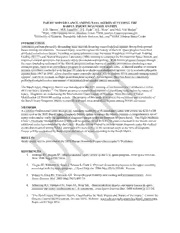
NASA Technical Reports Server (NTRS) 20140014056: Injury Surveillance Among NASA Astronauts Using the Barell Injury Diagnosis Matrix PDF
Preview NASA Technical Reports Server (NTRS) 20140014056: Injury Surveillance Among NASA Astronauts Using the Barell Injury Diagnosis Matrix
INJURY SURVEILLANCE AMONG NASA ASTRONAUTS USING THE BARELL INJURY DIAGNOSIS MATRIX J. D. Murray1, M.S. Laughlin2, D.L. Eudy3, M.L. Wear1, and M.G. Van Baalen4 1Wyle, 1290 Hercules Drive, Houston, Texas 77058, [email protected], 2University of Houston, 3Enterprise Advisory Services, Inc., and 4NASA Johnson Space Center INTRODUCTION Astronauts perform physically demanding tasks and risk incurring musculoskeletal injuries during both ground- based training and missions. Increased injury rates throughout the history of the U.S. space program have been attributed to numerous factors, including an aging astronaut corps, increased Weightless Environment Training Facility (WETF) and Neutral Buoyancy Laboratory (NBL) training to construct the International Space Station, and improved clinical operations that promote injury prevention and reporting. With NASA program changes through the years (including retirement of the Shuttle program) and an improved training environment (including a new astronaut gym), there is no surveillance program to systematically track injury rates. A limited number of research projects have been conducted over the past 20 years to evaluate musculoskeletal injuries: (1) to evaluate orthopedic injuries from 1987 to 19951, (2) to describe upper extremity injuries2, (3) to evaluate EVA spacesuit training related injuries3, and (4) to evaluate in-flight musculoskeletal injuries4. Nevertheless, there has been no consistently performed comprehensive assessment of musculoskeletal injuries among astronauts. The Barell Injury Diagnosis Matrix was introduced at the 2001 meeting of the International Collaborative Effort (ICE) on Injury Statistics.5 The Matrix proposes a standardized method of classifying body region by nature of injury. Diagnoses are coded using the International Classification of Diseases, Ninth Revision, Clinical Modification (ICD-9-CM) coding system. The purpose of this study is to assess the usefulness and complexity of the Barell Injury Diagnosis Matrix to classify and track musculoskeletal injuries among NASA astronauts. METHODS A Certified Professional Coder through the American Academy of Professional Coders will review the ICD-9-CM codes used in the 2005 Barell Injury Diagnosis Matrix update to ensure the Matrix contains a comprehensive set of injury codes and to verify the inclusion of diagnoses unique to the environment of space travel. The Flight Medicine Clinic’s Electronic Medical Record (EMR) will be queried for all ICD-9-CM codes contained in the Matrix and all additional codes recommended by the Coder. Results will be filtered to include recent diagnosis codes for medical events that occurred among NASA astronauts who were active in the astronaut corps at the time of diagnosis. Events will be categorized by body region and nature of injury according to the Barell Matrix. RESULTS Study results will be presented at the 2015 Human Research Program Investigator’s Workshop. REFERENCES 1. Jennings RT, Bagian JP. Musculoskeletal injury review in the U.S. space program. Aviat Space Environ Med. 1996 Aug;67(8):762-6. 2. Viegas SF, Williams D, Jones J, Strauss S, Clark J. Physical demands and injuries to the upper extremity associated with the space program. J Hand Surg Am. 2004 May;29(3):359-66. Review. 3. Strauss S, Krog RL, Feiveson AH. Extravehicular mobility unit training and astronaut injuries. Aviat Space Environ Med. 2005 May;76(5):469-74. 4. Scheuring RA, Mathers CH, Jones JA, Wear ML. Musculoskeletal injuries and minor trauma in space: incidence and injury mechanisms in U.S. astronauts. Aviat Space Environ Med. 2009 Feb;80(2):117-24. 5. "The Barell Injury Diagnosis Matrix, Classification by Body Region and Nature of the Injury." Centers for Disease Control and Prevention, 24 June 2010. Website: www.cdc.gov/nchs/injury/ice/barell_matrix.htm. Retrieved 01 Sept 2014.
